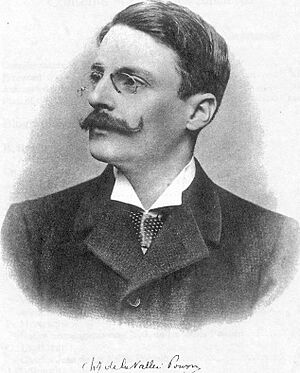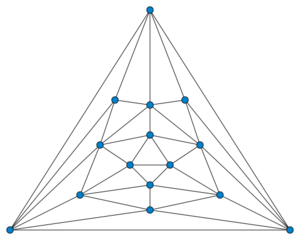Charles Jean de la Vallée Poussin facts for kids
Quick facts for kids
Baron
Charles Jean de la Vallée Poussin
|
|
|---|---|

Poussin, c. 1900
|
|
| Born |
Charles-Jean Étienne Gustave Nicolas, baron de la Vallée Poussin
14 August 1866 |
| Died | 2 March 1962 (aged 95) Watermael-Boitsfort, Brussels, Belgium
|
| Citizenship | Belgium |
| Alma mater | Catholic University of Leuven (1834–1968) |
| Known for | Poussin graph Poussin summability Poussin theorem Prime number theorem |
| Awards | Poncelet Prize (1916) |
| Scientific career | |
| Fields | Mathematics |
| Institutions | Catholic University of Leuven (1834–1968) |
| Doctoral students | Georges Lemaître |
Charles-Jean Étienne Gustave Nicolas, baron de la Vallée Poussin (born August 14, 1866 – died March 2, 1962) was a famous Belgian mathematician. He is best known for proving the prime number theorem. This is a very important rule in mathematics.
The King of Belgium gave him the special title of baron. This was to honor his great work.
Contents
About Charles-Jean de la Vallée Poussin
De la Vallée Poussin was born in Leuven, Belgium. He studied mathematics at the Catholic University of Leuven. He first earned a degree in engineering.
His uncle, Louis-Philippe Gilbert, was also a mathematician and taught him. Charles-Jean was encouraged to study for a doctorate in physics and mathematics. In 1891, when he was just 25, he became an assistant professor. He taught mathematical analysis.
Becoming a Professor
De la Vallée Poussin became a full professor at the same university in 1892. His father, Charles Louis de la Vallée Poussin, also taught there. He taught about minerals and rocks.
When his uncle Gilbert passed away, Charles-Jean took over his teaching position. While he was a professor, he did research in mathematical analysis and number theory. He won the Decennial Prize for Pure Mathematics twice. This prize was for his best work over ten years.
In 1898, he joined the Royal Belgian Academy of Sciences. He became a full member in 1908. In 1923, he became the President of the Science section.
Life During Wartime and Travel
In August 1914, World War I started. The German Army attacked Leuven. De la Vallée Poussin had to escape from the city.
He was invited to teach at Harvard University in the United States. He accepted this offer. In 1918, he returned to Europe. He taught in Paris at the Collège de France and the Sorbonne.
After the war, de la Vallée Poussin went back to Belgium. He became the President of the International Union of Mathematicians. Between 1918 and 1925, he traveled a lot. He gave lectures in many cities like Geneva, Strasbourg, and Madrid. He also lectured at many universities in the United States.
Awards and Honors
He received the Prix Poncelet in 1916. Many universities gave him honorary doctorates. These included the Universities of Paris, Toronto, and Oslo.
He also became a member of important groups like the Pontifical Academy of Sciences. In 1928, King Albert I of the Belgians gave him the title of Baron.
In 1961, de la Vallée Poussin broke his shoulder. This accident led to his death a few months later in Watermael-Boitsfort, near Brussels, Belgium.
One of his students was Georges Lemaître. Georges Lemaître was the first person to suggest the Big Bang theory. This theory explains how the Universe began.
His Important Mathematical Work
Charles-Jean de la Vallée Poussin first studied mathematical analysis. But he became very famous for proving the prime number theorem in 1896. Another mathematician, Jacques Hadamard, proved it at the same time.
What is the Prime Number Theorem?
The prime number theorem helps us understand prime numbers. Prime numbers are numbers that can only be divided by 1 and themselves (like 2, 3, 5, 7, 11). The theorem tells us how prime numbers are spread out among all numbers. It helps predict how many prime numbers there are up to a certain point.
The Poussin Graph
De la Vallée Poussin also worked on a famous problem called the four color theorem. This theorem says that you only need four colors to color any map so that no two neighboring regions have the same color.
He found a special graph that showed a mistake in an earlier attempt to prove this theorem. This graph is now called the Poussin graph after him.
His Famous Textbooks
De la Vallée Poussin wrote textbooks for his mathematical analysis course. These books were very important for a long time. They were used by students all over the world.
The second edition of his book, published in 1909-1912, was special. It was one of the first textbooks to include the Lebesgue integral. This is an advanced way to measure areas and volumes in mathematics.
The third edition, from 1914, introduced a new way to define what a differentiable function is. Sadly, the second volume of this third edition was burned. This happened during the fire of Louvain when the Germans invaded Belgium in 1914.
Later editions of his books were more like the first one. After the eighth edition, another mathematician, Fernand Simonart, took over updating and publishing the Cours d’analyse.
See also
 In Spanish: Charles-Jean de la Vallée Poussin para niños
In Spanish: Charles-Jean de la Vallée Poussin para niños
- Poussin proof
- Remez algorithm
- La Vallée-Poussin


